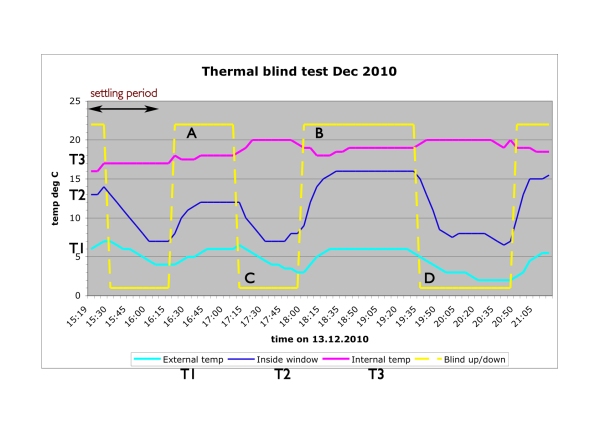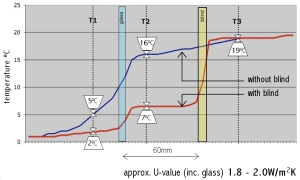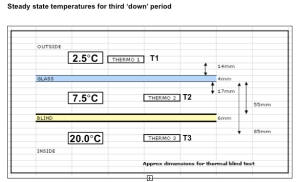technical
Download the technical report HERE (10.8MB).
The five layers of the blinds are;
1. Room side fabric – 100% polyester with blackout surface, H&S fabrics ‘Waldorf’ range
2. 12mic Aluminised Mylar MET813 (space blanket)
3. 7mm C100 Thinsulate, 3M, (‘Clo’ value of circa 1.1)
4. 12mic Aluminised Mylar MET813
5. 110g cotton polyester sateen lining fabric (other choices available)
The inner layers incorporate a 7mm ‘Thinsulate’ core (a highly insulating thermal fleece, normally used for clothing), with two layers of aluminium faced Mylar (‘space blanket’ material as developed by NASA) either side of the core.
Technical performance
In December 2010 a six hour test of the blinds performance was undertaken using the prototype fitted to a typical single-glazed Victorian window. The results showed that the blinds prevent a significant heat loss through the window glass & improve the comfort levels (and downdraft) close to the window, internally. From this a guide U-Value of the blinds has been ascertained and hot-box tests are planned at the National Physics Lab (see Retrofit for the Future info). Ultimately the approximate heating cost savings and payback period for the blinds can be estimated. Download the full report HERE (10.8MB).
extracts;
The average outside temperature was around 3˚C & internal temperature 20˚C.
Results show;
A. With no blind in place the external temperature at 14mm from outside surface of the glass rises significantly from ambient external temperature (by about 3˚C).
B. With no blind in place temperatures just inside the glass (17mm) are generally between 6 – 10˚C warmer than ambient external, [but NB 2˚C internal temp difference between two periods]. Average temp. was 8.0˚C.
C. With no blind in place temperatures just inside the glass (17mm) are generally between 3 – 6˚C cooler than ambient internal. [Note that first ‘up’ period is relatively short]. Mean is 4.0˚C cooler.
D. With the blind in place temperatures just inside (17mm) the glass are generally between 3 – 5˚C warmer than ambient external temperature. Average 4˚C warmer.
E. With the blind in place (down), the temperature just inside the glass (17mm) was generally around 12.5˚C cooler than ambient internal temperature (20˚C). This gives an indication of the performance of the blind & from this an assumed U-Value can be calculated.





Your blinds sound wonderful. We live in a 17c cottage, grade 2 listed and my husband protects all original features with his life! . Before I suggest the blinds to him could you give me an approx price per metre please.
Hi Eliza, The price for a typical window is £170 per sq.m for the standard headrail, more for the deluxe (£180/sq.m) or blinds smaller than 1 sq.m or particularly large blinds. You can also choose metal chain in lieu of plastic, or heavy duty 1:4 chain drives for the larger blinds. They are very simple to install yourself but sometimes require a small wooden subframe (but not for sash windows). The deluxe headrail is neater & the folds are shorter so it blocks less of the light/view when the blinds are raised.
Hope that helps. Send me a photo & I’ll let you know if the blinds are suitable in your particular case.